Winter in Ely
At the edge of the wilderness, fun starts when the snow falls.
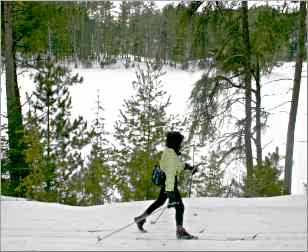
© Beth Gauper
Around Ely, beauty is stripped down to essentials.
There's little but water, stone, spruce and sky in the northern Minnesota wilderness, what conservationist Sigurd Olson called "the naked grandeur." Still, it enthralls visitors from all over the world.
In winter, snow, ice and silence settle over the forests and lakes, and stars plaster the inky night sky. For many, Ely's pull is even stronger then.
"Most of us who live here do find winter to be our favorite season," says longtime inn proprietor Jo Kovach.
"It's peaceful, tranquil and beautiful — I often talk about how noisy it is when the trees first leaf out in the spring and you hear the roaring of the millions of acres of trees around us. But the only sound you hear in winter is the birds and this wonderful silence."
Ely is famous for being the favorite destination of such celebrities as Charles Kuralt and the chosen home of photographer Jim Brandenburg, Sigurd Olson and polar explorers Will Steger and Paul Schurke. People who see it tend to love it — but not always.
One winter, a Seattle family of four landed in Ely, the first winners of a reality show called "The Vacation You Need," produced for the Travel Channel. The family thought they'd won a beach vacation but ended up with a sled-dog camping trip from Schurke's Wintergreen Lodge, a well-known outfitter to which people flock from all over the world.
The first impulse of the family from Seattle, however, was to flee.
"It was a real eye-opener for us to realize there are people out there for whom this is truly, absolutely not their cup of tea," Schurke said. "The father was angry. The mother was upset. The daughter had an iPod in one ear and a cell phone in the other, and I don't think they came out the whole trip."
But Ely was at its most dazzling, with sun sparkling on a layer of new snow, and eventually the family came around. They learned how to use a compass, and the mother and daughter won an orienteering challenge.
The daughter was first to jump through the ice after a soak in the sauna, and the son asked if he could apply for an internship with Schurke.
And while most clients fall in love with the sled dogs, Schurke said, these fell in love with the stars.
"We take this for granted up here, but they were absolutely enchanted with the night sky," he said. "They were out on the lake most every evening, wanting us to identify the various constellations."
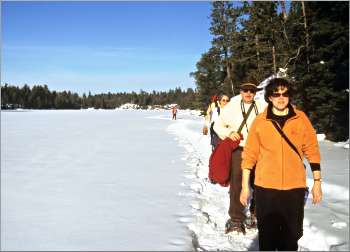
© Beth Gauper
Hobnobbing with sled dogs
Sometimes, people arrive with the stars stuck firmly in their eyes.
When we were in Ely one February, we stayed at an inn with four people on a Wintergreen trip. They were enthralled with the dogs: "They're so wonderful," said Lynne Olds of Campbell, Calif. "They have such personality, and they work so hard, it's just a pleasure."
In the morning, we watched them help guides Chris Maher and Mark Schurke harness teams of Canadian Inuit dogs, each capable of pulling 550 pounds.
"If people are fit, we can take them on a crazy wild ride," said Schurke, Paul's nephew. "If they just want a leisurely ride through the woods, we can do that, too."
After watching the sleds hurtle across South Farm Lake and into the forest, with Schurke flying ahead on skis, we borrowed some of the Blue Heron's snowshoes and headed to the North Arm of Burntside Lake.
From the parking lot, we snowshoed through a magnificent old-growth forest and up the ridge above Slim Lake until we reached Old Baldy, a quartzite outcropping where we sat in a warm breeze, a panorama of forests and lakes spread beneath us.
That was our second snowshoe trek of the weekend. During Winter Festival, the Ely office of Outward Bound usually leads a trip to the pictographs on North Hegman Lake.
With three leaders and 17 other people, we trudged up from South Hegman Lake, the slushy lake ice slurping at our snowshoes, until we were standing in front of the ancient red figures.
Drawn on rock 500 or 1,000 years ago, they depict a moose, an otterlike animal, a figure that may be human or superhuman and perhaps some constellations — no one knows for sure.
We did, however, know what had made the tracks in the snow that crossed and meandered past our own tracks — thanks to Laura Prugh, a biologist from Vancouver, British Columbia, who earned her doctorate tracking coyotes in Alaska.
"That's the great thing about winter; everything leaves a trace," Prugh said.
Sculpting in snow
In Ely's Whiteside Park, teams of sculptors were trying to make their mark in the snow, too, but the warmth was taxing their patience.
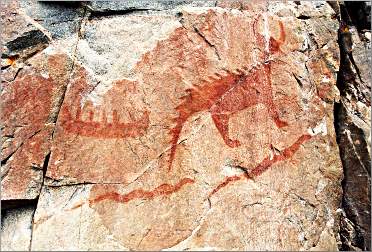
© Beth Gauper
Anne DesLauriers of Ely was one of three women working on a piece called "Going With the Flow," and "yesterday, it was almost literally flowing," she said.
Grant Harrison had made a piece he dubbed "Mountain Lions Don't Like Warm Weather." "I completed it at 12:50 a.m., and it collapsed at 12:51 a.m.," he said. "It was awesome."
In the professional categories, one of the most striking pieces was "Ravenous," a classical sculpture of a raven picking at a tipped-over basket of fruit.
"We're all artists in regular life, so it's nice to do something fun," said frame-shop owner Penny Perry.
The warm temperatures were good for roaming Sheridan Street, however, and shoppers were hopping from sale to sale, perusing the northwoods goods at Steger Mukluks, Piragis and Wintergreen Designs. Even the Brandenburg Gallery was having a White Sale, 25 percent off any print or card that featured snow or ice.
In Ely, Jim Brandenburg's spectacular assemblage of photographs is right up there with the International Wolf Center as a town attraction.
Somehow, Brandenburg is able to capture moments in nature that most people have never seen, much less photographed — northern lights in a tie-dyed sky, a baby snowshoe hare yawning in the sun, a timber wolf sitting in a pool of light on the side of a shadowy mountain.

© Beth Gauper
After mingling with the mukluk-shod, parka-clad crowds on Sheridan Street, we headed for the International Wolf Center, home of real wolves.
After scrutinizing a map that showed the whereabouts of the local wolves — one of them, a 78-pound male, was last pinpointed around the Blue Heron, and two young females were nearby — we watched a film about the reintroduction of wolves at Yellowstone.
The subplots — about a submissive "Cinderella sister" and an outcast male — were fascinating, a story of playground politics on a life-or-death scale.
"The roles in the pack are never stagnant," naturalist Erin Albers told us. "They're always being reinforced, they're always being tested."
Drama with wolves
To those who watch, the latest celebrity news is a snoozer compared with the goings-on in the pack.
In a wolf pack, attitude matters more than size. In 2005, the 1-year-old female Nyssa had grown larger than her sister Maya. But when workers were building a rock wall for the habitat, the normally feisty Nyssa showed fear of the wheelbarrow, and her packmates likely perceived it as a weakness.
That spring, Maya may have dealt with her larger sister for good: Six days after she and Nyssa were spayed, Nyssa was found with injuries from an attack so severe she had to be euthanized. Maya became the dominant female until her death in 2011.
But aggression without leadership can doom a wolf, too. In 2016, the 4-year-old Great Plains wolf Luna had to be retired because of her intense behavior toward two new Arctic gray wolf pups, Greyson and Axel.
We were lucky; we got to see all of the wolves, sometimes nearly nose-to-nose but for the plate-glass wall that separates the small auditorium from their home.
In addition to Greyson and Axel, the exhibit pack includes Rieka, born in 2021, and Blackstone and Caz, born in 2022.
Winter is a good time to watch the wolves, who often retreat to the shade of trees in summer.
Ely may be best known for summer canoeing and sky-blue waters. Blue is good, in its time. But in winter, white is the welcome color.
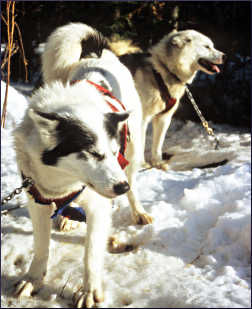
© Beth Gauper
Trip Tips: Ely, Minnesota, in winter
Getting there: It's about four hours from the Twin Cities. The easiest way to get there is via Minnesota 33 from Cloquet, U.S. 53 through Virginia, then Minnesota 169 east.
When to go: January, February and March are peak for winter sports.
Annual events: Early February, Winter Festival. In Whiteside Park, the region's most accomplished snow-sculpture artists whip up whimsical figures; there's also an art walk, guided snowshoe hikes and a candlelight ski.
Last Sunday of February, Wolf Track Classic Sled Dog Race, with teams racing from Ely to Tower and on to Cook.
Visitors may want to plan ahead for the biggest warm-weather events — Blueberry Arts Festival the last weekend of July and the Harvest Moon Festival the weekend after Labor Day.
For more, see Dreaming of Ely.
Nightlife: The restored 1936 Historic State Theater on Sheridan Street is the cultural hub.
Snowshoeing: Ely is surrounded by Superior National Forest and the Boundary Waters Canoe Area Wilderness (free day-use permit required), so possibilities are endless.
Good trails include the flat 3 kilometers to the Hegman Lake pictographs (park off the Echo Trail or County Road 116, 15 miles north of town) and alongside the user-tracked, hilly North Arm ski trails, reached by turning onto North Arm Road or County Road 644 from the Echo Trail.
Skiing: Near the International Wolf Center, the Ely Nordic Association maintains the 15-kilometer Hidden Valley system, groomed for striding and skating.
The Hidden Valley trails connect to the Silver Rapids trails, 8 kilometers that are groomed for striding only and have overlooks of Farm Lake. A Minnesota Ski Pass is required, $10 daily, $25 annually, $70 for three years.
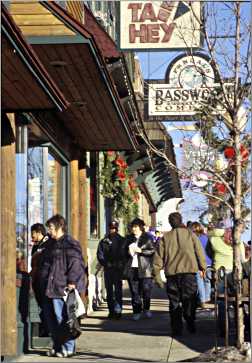
© Beth Gauper
East of town, the Jasper Hills trails have 36 kilometers groomed for striding, $5-$8. The North Arm Trail 's 30 kilometers are user-tracked but very scenic.
Dog-sledding: Several outfitters offer mushing trips. The best-known is Paul Schurke's Wintergreen Lodge, which offers a variety of lodge-based, lodge-to-lodge and camping dog-sledding trips.
International Wolf Center: It's open Friday-Sunday in winter and daily from mid-May to mid-October. Admission is $18, $12 for children 4-12. Films and presentations are given throughout the day.
The wolves' weekly feeding of roadkill at 7 p.m. Saturdays is an additional fee; register by calling 800-359-9653, Ext. 21.
The staff gives webinars about pack dynamics and on each wolf on its birthday.
Ely Folk School: This school teaches lots of weekend classes in such northwoods skills and crafts as canoe-building, wood-carving and loom-weaving.
Accommodations: Downtown, A Stay Inn Ely has five rooms, one handicapped-accessible. Two rooms sleep three, one sleeps four and one sleeps five.
Also downtown are two motels, the Adventure Inn and Motel Ely Budget Host.
Grand Ely Lodge is a resort/conference center a mile north of downtown, on a ridge above Shagawa Lake.
West of town, Bear Head Lake State Park has a guesthouse and five heated camper cabins. For more, see Ensconced in Ely.
Ten miles southwest of town on Bear Island Lake, the YMCA's Camp Northern Lights rents cabins to individuals and groups in winter.
Dining: On Sheridan Street, Insula Restaurant offers fresh takes on burgers and sandwiches and also offers such entrees as free-range fried chicken and braised lamb shank.
Also on Sheridan, the BoatHouse Brewpub & Restaurant serves a large menu of burgers, sandwiches, Mexican dishes, pasta and steaks. A block over, the Chapman Street Market sells panini, soups and salads in addition to artisan breads and cheeses.
Information: Ely tourism, 218-365-6123.